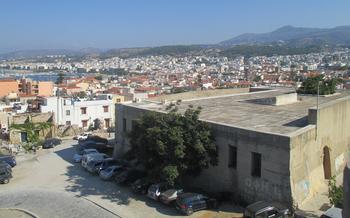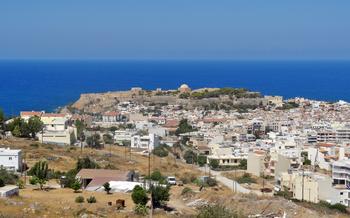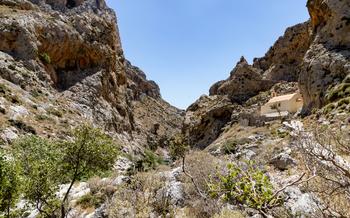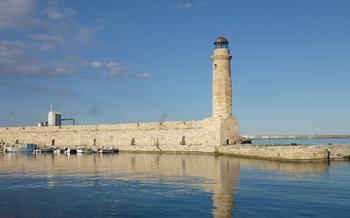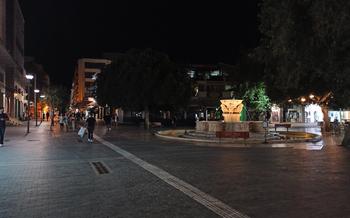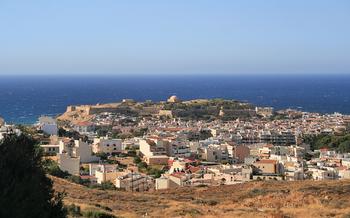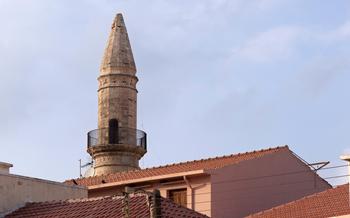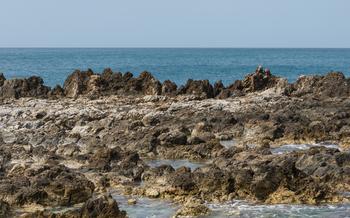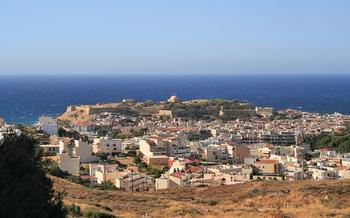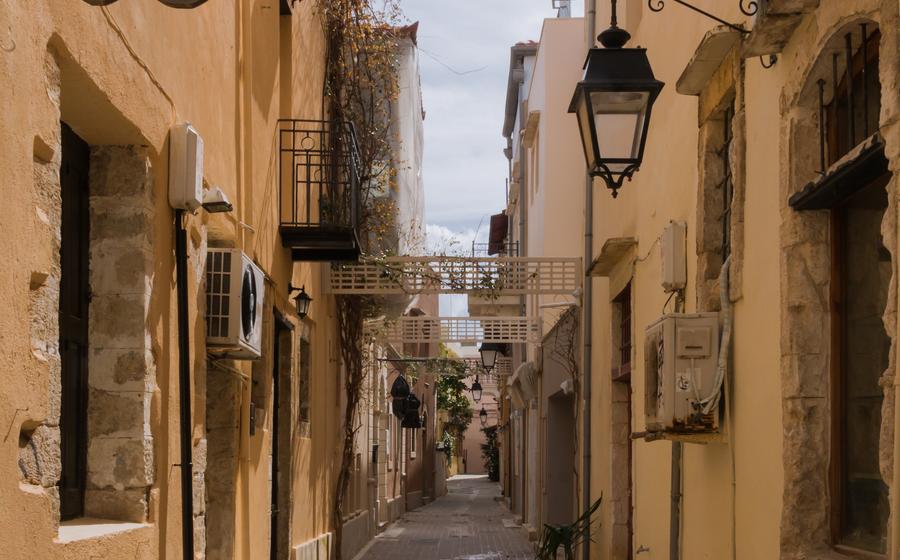
Paleontological Museum of Rethymno
- Paleontological Museum of Rethymno: A Journey Through Time
- Paleontological Heritage
- Exhibits and Displays
- Fossil Collection
- Educational Programs
- Temporary Exhibitions
- Guided Tours
- Museum Shop
- Accessibility
- Location and Getting There
- Admission and Tickets
- Museum Hours and Days
- Nearby Attractions
- Insider Tip: Embark on a Journey Through Time
Paleontological Museum of Rethymno: A Journey Through Time
History of the Museum:
In the heart of the beautiful city of Rethymno, nestled within the majestic walls of the Venetian Fortezza, lies the captivating Paleontological Museum of Rethymno. Inaugurated in 1992, this museum serves as a testament to the rich paleontological heritage of Crete and the tireless efforts of local enthusiasts to preserve it. It all began with the donation of a remarkable collection of fossils by the late George Psilakis, a passionate amateur paleontologist who dedicated his life to unearthing the secrets of Crete's prehistoric past. Inspired by his dedication, the municipality of Rethymno established the museum to showcase these invaluable treasures and educate the public about the wonders of paleontology.
Paleontological Heritage
The geological formations found in Crete are of exceptional significance, as they represent a diverse array of environments that existed millions of years ago. These formations include marine deposits, continental deposits, and volcanic rocks, each preserving a unique record of ancient life.
The Paleontological Museum of Rethymno showcases a remarkable collection of fossils that have been discovered in Crete and the surrounding region. These fossils represent a wide range of organisms, including marine invertebrates, fish, reptiles, birds, and mammals. Among the highlights of the collection are the well-preserved remains of a giant marine reptile known as a mosasaur, as well as the fossilized footprints of dinosaurs.
Of particular interest are the unique and rare fossils that provide valuable insights into the evolution of life on Crete. These include the remains of a small, primitive elephant known as Deinotherium, as well as the fossilized teeth of a giant shark called Megalodon.
The museum's collection serves as a valuable resource for paleontological research and contributes to our understanding of the ancient history of Crete and the Mediterranean region. It also emphasizes the importance of protecting and preserving our paleontological heritage, ensuring that future generations can continue to learn and appreciate the wonders of the natural world.
Exhibits and Displays
The Paleontological Museum of Rethymno boasts a diverse range of exhibits and displays that captivate visitors of all ages. The museum takes a chronological approach, showcasing fossils from the earliest geological periods to the more recent ones. Visitors can trace the evolution of life on Earth through the various exhibits, which include:
-
The Palaeozoic Era: This exhibit showcases fossils from the Palaeozoic Era, including trilobites, brachiopods, and crinoids. These fossils offer a glimpse into the ancient marine ecosystems that existed millions of years ago.
-
The Mesozoic Era: The Mesozoic Era exhibit features fossils from the time of dinosaurs, such as teeth, bones, and footprints. Visitors can learn about the different types of dinosaurs that roamed the Earth during this era and admire the remarkable preservation of these ancient creatures.
-
The Cenozoic Era: The Cenozoic Era exhibit showcases fossils from the most recent geological period, including mammals, birds, and plants. This exhibit highlights the evolution of modern-day species and provides insights into the changes that have occurred in the Earth's ecosystems over time.
Each exhibit is accompanied by detailed labels and informational panels that provide context and scientific explanations. Interactive displays, such as touchscreens and multimedia presentations, enhance the learning experience and make the museum accessible to visitors of all backgrounds.
Fossil Collection
The Paleontological Museum of Rethymno houses an impressive collection of over 3,000 fossils, primarily from the Pliocene and Pleistocene geological epochs. These fossils represent a diverse range of species, including marine invertebrates, fish, reptiles, birds, and mammals. The collection is particularly rich in marine fossils, reflecting the region's rich marine history.
The process of fossil collection and preparation is a meticulous and time-consuming one. Fossils are carefully excavated from their original locations using specialized tools and techniques. Once excavated, the fossils are cleaned and prepared for study and display. This involves removing any surrounding sediment or matrix and preserving the fossil's structural integrity.
The museum collaborates with various research institutions and universities to conduct scientific research and studies on the fossils. These studies focus on various aspects of paleontology, including taxonomy, paleoecology, and evolutionary history. The museum's collection has contributed significantly to our understanding of the past life and environments of Crete and the surrounding region.
One of the most significant discoveries made at the museum was the identification of a new species of extinct giant tortoise, named Testudo rethymnensis. This discovery was based on a partial skeleton found in the Pliocene deposits of southern Crete. The giant tortoise was estimated to have weighed over 500 kilograms and was likely a herbivore that played an important role in the island's ecosystem.
Educational Programs
The Paleontological Museum of Rethymno recognizes the importance of educating the public about paleontology and the significance of preserving our natural heritage. To this end, the museum offers a range of educational programs and activities designed to engage and inspire visitors of all ages. These programs include:
-
Workshops: The museum hosts regular workshops that provide hands-on experience with fossils and paleontological techniques. Participants can learn about fossil preparation, identification, and the scientific study of fossils.
-
Lectures: The museum organizes lectures and talks by renowned paleontologists and experts in the field. These lectures cover a variety of topics related to paleontology, from the evolution of life on Earth to the latest discoveries in the field.
-
Guided Tours: Guided tours of the museum are available for groups and individuals. Led by experienced docents, these tours provide an in-depth exploration of the exhibits and collections, allowing visitors to learn more about the fascinating world of paleontology.
-
School Programs: The museum offers educational programs specifically tailored for schools and student groups. These programs include interactive activities, demonstrations, and hands-on experiences that help students learn about paleontology in a fun and engaging way.
One successful educational program at the museum is the "Fossil Detectives" workshop, which invites children to become paleontologists for a day. During the workshop, children learn how to identify and classify fossils, and they even get to take home their own fossil specimens. This program has been praised by parents and educators for its ability to spark children's interest in science and paleontology.
Temporary Exhibitions
The Paleontological Museum of Rethymno regularly hosts temporary exhibitions to showcase new discoveries, highlight specific themes, or collaborate with other institutions. These exhibitions provide a dynamic and engaging platform to explore various aspects of paleontology and related fields. Past temporary exhibitions have covered topics such as the evolution of marine reptiles, the fascinating world of dinosaurs, and the paleontological treasures of the Mediterranean region.
One notable temporary exhibition was titled "Dinosaurs of the Deep: Ancient Marine Reptiles of Crete." This exhibition featured a stunning collection of fossils and life-sized models of marine reptiles that once inhabited the waters surrounding Crete during the Mesozoic Era. Visitors were able to learn about the diversity and adaptations of these ancient creatures, including mosasaurs, plesiosaurs, and turtles.
The museum also collaborates with local schools and universities to organize educational temporary exhibitions. These exhibitions often focus on specific topics related to the school curriculum, such as the history of life on Earth, the process of fossilization, or the importance of paleontological research. These exhibitions play a crucial role in fostering scientific curiosity and engaging young minds with the wonders of paleontology.
Guided Tours
The Paleontological Museum of Rethymno offers guided tours to enhance the visitor experience. These tours are led by knowledgeable and enthusiastic guides who bring the exhibits to life with their expert insights and engaging storytelling. Taking a guided tour is an excellent way to learn more about the fascinating world of paleontology and gain a deeper understanding of the museum's collection.
Visitors can choose from a variety of guided tours, tailored to different interests and group sizes. Group tours are available for schools, families, or organized groups, while private tours offer a more personalized experience for individuals or small groups. Specialized tours are also available, focusing on specific topics such as the evolution of life on Earth or the paleontology of Crete.
One visitor, Maria, shared her positive experience with a guided tour: "Our guide was incredibly knowledgeable and passionate about paleontology. He made the exhibits come alive and answered all our questions. We learned so much and had a truly memorable experience."
Whether you're a paleontology enthusiast or simply looking to explore the wonders of the natural world, a guided tour of the Paleontological Museum of Rethymno is highly recommended.
Museum Shop
The Paleontological Museum of Rethymno houses a well-stocked museum shop that caters to visitors of all ages. Here, you can find a diverse selection of souvenirs, educational materials, and unique merchandise related to paleontology. From intricately designed fossil replicas to informative books and posters, the museum shop offers a treasure trove of items to commemorate your visit.
One of the highlights of the museum shop is the collection of fossil-themed jewelry. These exquisite pieces, crafted from genuine fossils or fossil imprints, make for memorable keepsakes or gifts. Visitors can choose from a variety of necklaces, bracelets, earrings, and pendants, each showcasing the beauty and diversity of ancient life forms.
In addition to fossils and jewelry, the museum shop also offers a range of educational materials and books. These publications cover various aspects of paleontology, including the history of life on Earth, the processes of fossilization, and the significance of paleontological discoveries. Whether you are a budding paleontologist or simply curious about the ancient world, these books provide an excellent opportunity to deepen your knowledge and understanding.
By making a purchase at the museum shop, you not only take home a unique souvenir but also contribute to the museum's ongoing research and educational initiatives. Your support helps ensure that the museum can continue to preserve and share the wonders of paleontology with future generations.
Accessibility
The Paleontological Museum of Rethymno is committed to providing an inclusive and accessible environment for all visitors. The museum features wheelchair ramps, elevators, and accessible restrooms, ensuring that visitors with disabilities can navigate the museum comfortably. Additionally, the museum offers sign language interpretation and educational materials in Braille upon request. Staff members are trained to assist visitors with disabilities, providing them with the necessary support and information to have a fulfilling and enjoyable experience.
One heart-warming anecdote highlights the museum's dedication to inclusivity. A young girl with a visual impairment visited the museum with her family. The museum staff provided her with tactile models of the fossils, allowing her to "see" and understand the exhibits in a unique way. The girl was thrilled to be able to engage with the museum's collection and left feeling inspired and empowered.
Location and Getting There
The Paleontological Museum of Rethymno is strategically situated in the heart of the city, at 11 Arkadiou Street. Its central location makes it easily accessible on foot or by public transportation. For those arriving by car, there are several parking facilities nearby, including the Municipal Parking Lot at the Venetian Port, just a short walk from the museum. To avoid the summer crowds and enjoy a more leisurely visit, consider exploring the museum in the morning or during the shoulder seasons (spring or fall).
Admission and Tickets
Visiting the Paleontological Museum of Rethymno is an affordable and accessible experience. The admission fees are set at a reasonable rate, allowing visitors from all backgrounds to enjoy the museum's offerings. To further promote inclusivity, the museum offers discounted rates for students, seniors, and families. Additionally, online booking options are available for those who prefer to plan ahead and secure their tickets in advance.
Tip: Take advantage of the reduced admission fees by purchasing tickets online. This not only saves you time at the museum but also allows you to avoid any potential queues during peak tourist season.
Museum Hours and Days
The Paleontological Museum of Rethymno welcomes visitors throughout the week, offering ample opportunities for exploration and learning. Its doors are open from Tuesday to Sunday, allowing both locals and tourists to delve into the captivating world of paleontology. During the summer months, from April to October, the museum extends its hours, inviting visitors to immerse themselves in its exhibits from 9:00 AM to 8:00 PM. In the off-season, from November to March, the museum maintains a slightly shorter schedule, operating from 8:30 AM to 3:00 PM. It's essential to note that the museum remains closed on Mondays, allowing the staff to prepare for the upcoming week and ensure the exhibits' upkeep.
To avoid any inconvenience during your visit, it's advisable to plan your itinerary accordingly. If you're seeking a more tranquil experience, consider visiting the museum during the weekdays, as weekends tend to attract larger crowds. Additionally, arriving early in the morning or towards the end of the day can help you beat the rush and enjoy a more intimate exploration of the museum's treasures.
Nearby Attractions
The Paleontological Museum of Rethymno is conveniently located in the heart of the city, making it easy to explore other attractions in the area. Visitors can stroll through the picturesque Old Town of Rethymno, with its narrow cobbled streets, Venetian mansions, and lively atmosphere. The Venetian Fortress, built in the 16th century, offers stunning panoramic views of the city and the sea. For those interested in history, the Archaeological Museum of Rethymno showcases artifacts from the Minoan, Roman, and Byzantine periods.
Nature lovers can enjoy the nearby Rethymno Beach, with its crystal-clear waters and golden sands. The beach is ideal for swimming, sunbathing, and water sports. The Arkadi Monastery, a historic and scenic site, is just a short drive from the museum. Founded in the 16th century, the monastery played a significant role in the Cretan struggle for independence from the Ottoman Empire.
To create a comprehensive itinerary for a day in Rethymno, visitors can start by exploring the Paleontological Museum in the morning. Afterward, they can wander through the Old Town, visit the Venetian Fortress, and have lunch at one of the traditional tavernas. In the afternoon, they can relax on Rethymno Beach or take a boat trip to the nearby island of Dia. The day can end with a visit to the Arkadi Monastery, followed by dinner at a restaurant with live Cretan music.
Insider Tip: Embark on a Journey Through Time
Unleash your inner explorer and embark on a captivating journey through time at the Paleontological Museum of Rethymno. As you wander through the exhibits, let your imagination soar and picture yourself millions of years ago, surrounded by the awe-inspiring creatures that once roamed the Earth. Don't miss the opportunity to marvel at the exquisitely preserved fossils of giant prehistoric animals, including the impressive tusk of a mastodon. Immerse yourself in the interactive displays and educational programs to gain a deeper understanding of the remarkable paleontological heritage of Crete. The museum offers a unique and unforgettable experience that will ignite your curiosity and leave you with a newfound appreciation for the wonders of the natural world.
